Safavid Figurative Textiles
During the Safavid period (1501-1722) older styles of fabric decoration continue, including small floral "arabesques" and small repeated animals.
More striking are figurative fabrics. While figurative patterns on textiles has a long history in Persia, two particular styles emerged in the Safavid period. One is of small framed vignettes, often from well-known stories. The other involves large images of humans involved in various activities.
Figurative motifs are found on brocades, lampas weaves, and brocaded cut velvets, among other textile techniques. Another distinctively Safavid style shows multicolored plants and sometimes animals on an almost sheer (yes, sheer) metallic silver ground, or a ground of deep red or indigo.
I apologize for the quality of some of these pictures. The black-and-white photos are from a very old, but very useful and expansive multi-volume "A Survey of Persian Art", by Arthur Upham Pope and later expanded by his wife Phyllis Ackerman. |
Vignettes
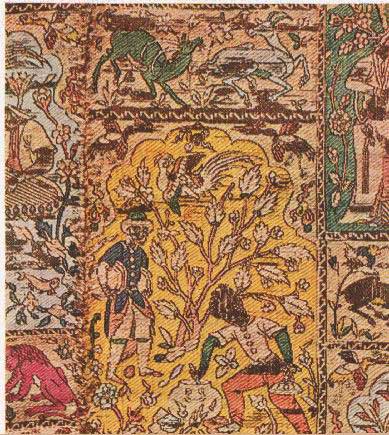
Silk with gold and silver metallic threads, complex weave
2nd Half of the 16th century
Victoria and Albert Museum
Various scenes of men and women in a garden alternate with panels of animals and plants.
|
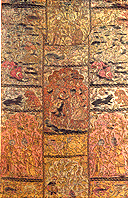
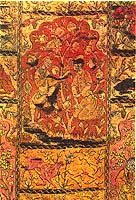 
Silk with gold and silver metallic threads, complex weave
16th century
The Museum of Oriental Art
This is the identical pattern as in the fragment to the left in the V&A
The detail here would be the panel above the one in the V&A
|
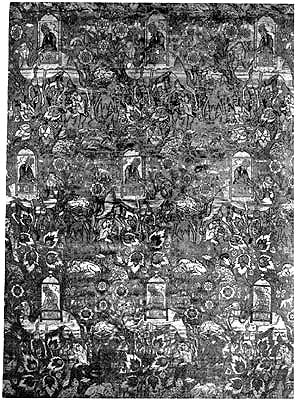
Silk, lampas weave
16th century
A vignette from the romance of Laila and Majnun, a popular tragic love-story, illustrated in many paintings and in fabrics. In this fabric Laila is riding her camel to the desert to find her love Majnun, who has become a hermit. Laila on her camel is framed by conventional plant forms.

Detail, in Textile Museum, Washington DC, TM3.312
|
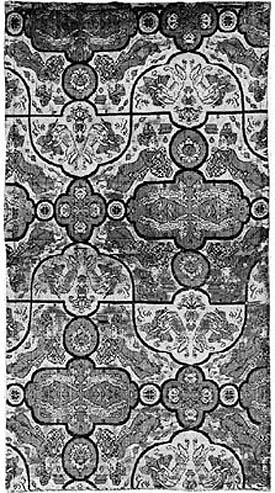
Silk, Lampas weave
16th century
Panels framing flowers, birds, animals, and a typical young courtier.
In three colors, green, rose and white.
|
Lampas weave is a complex technique, described by Arthur Pope as a "multiple cloth" technique in which "two or three plain cloths are woven as if each were independent, yet are passed back and forth to define the pattern and vary the color range, were utilized with every refinement of the technique for the execution of most difficult cartoons..." He believed that these two fragments, reproduced only in black-and-white in A Survey of Persian Art, were by the well-respected artist Ghiyath al-Din 'Ali of Yazd.
|
  | 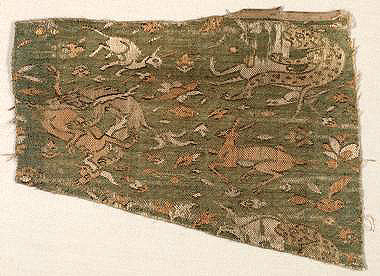 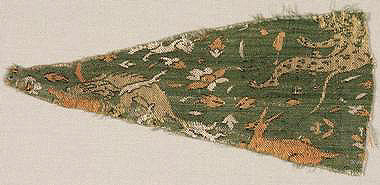 |
Fragments from the same cloth - and probably the same garment
Silk and gold metallic threads, lampas weave
16th C.
the Cleveland Museum of Art
When i was in Athens in 2019, i saw a length of this cloth, about 2 meters long (!!), uncut (!!), in the Benaki Museum of Islamic Art. It took my breath away. Dragons attack oxen, leopards attack wild asses. My blurry photo obviously doesn't do it justice.
|
Variations of this motif, a large feline attacking from the top, a prey animal, go back to the Scythians, and it is common in the textiles of many Central Asian and related cultures. It is common in Persian rugs, as well.
|
Large Scale Human Figures
While the most common motif to have survived is that of a youth in a garden holding a wine bottle and wine cup, we know of a number of other patterns involving humans.
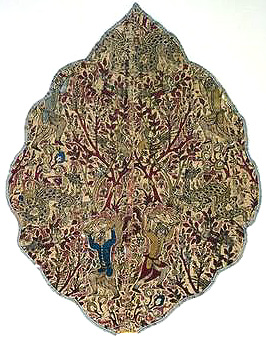
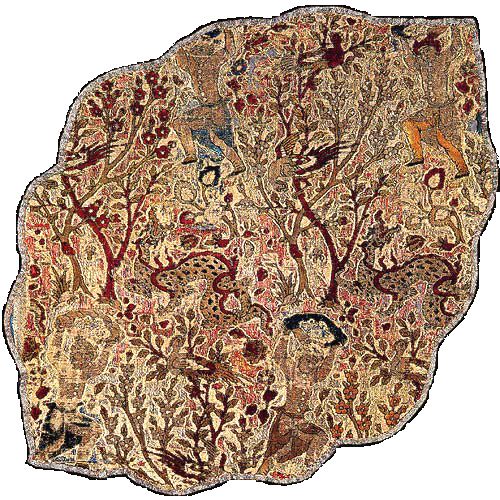 |
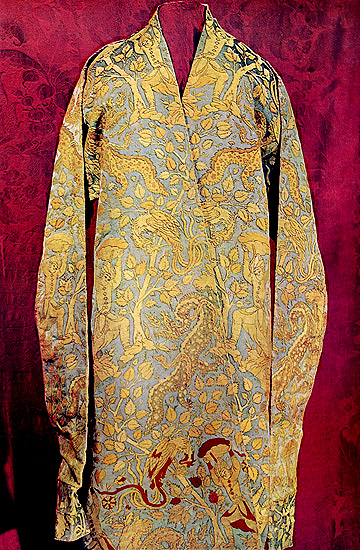 |
Small scale Dragonslayer motif in cut velvet
Top: Fragment in Cleveland Museum of Art
Botton: Fragment in Museu Gulbenkian, Lisbon, Portugal |
Compare with the same motif on a very large scale in brocaded lampas of the "Dragonslayer Coat", believed to have been a diplomatic gift from the Safavid Persia court to the Russian court in Moscow. |
|
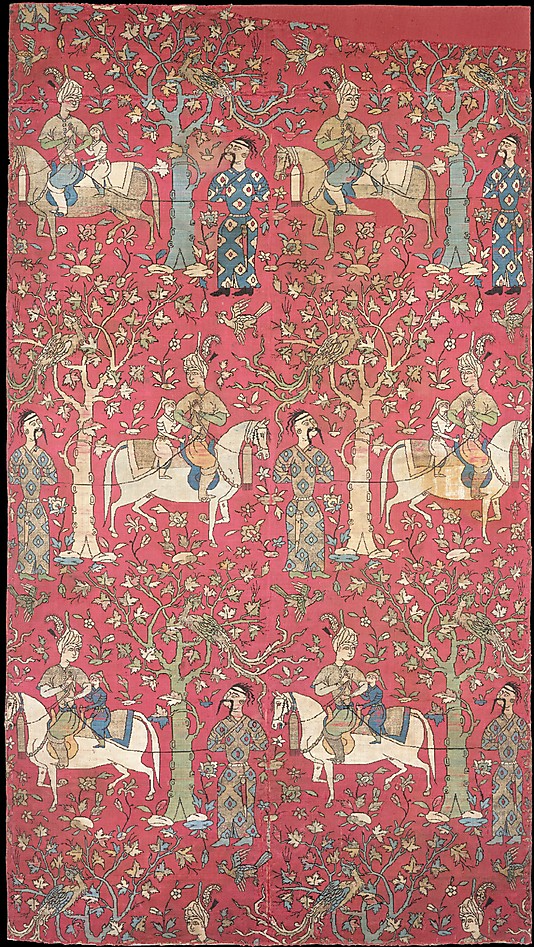
This fabric shows a horseman leading a bound Georgian captive on foot, in the style of the great textile designer Ghiyath al-Din Ali of Yazd. Silk and metal-wrapped threads, lampas weave: satin and twill weave interconnected. mid 16th c.
Metropolitan Museum of Art. | 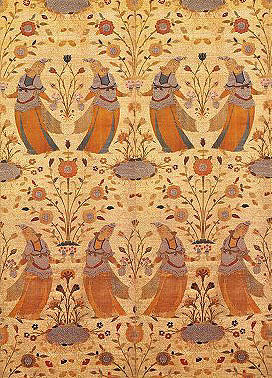
Riza Abbasi-style early 17th c. brocade |
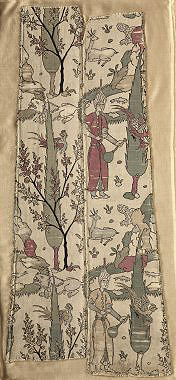
Cleveland Museum of Art | 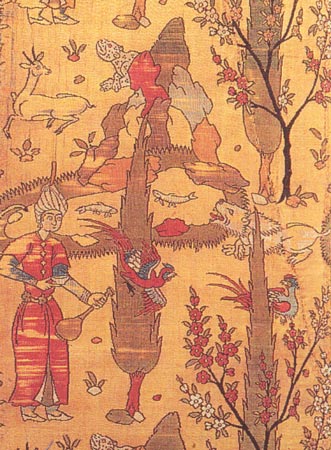
Same fabric, different collection
Fragments of this wine drinker in a landscape are also in the Los Angeles County Museum of Art (LACMA), the Metropolitan Museum of Art, and the Victoria & Albert Museum |
| Silk, Lampas weave, early 16th C |
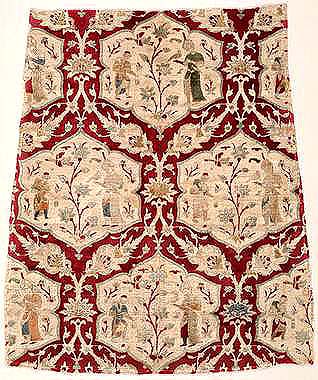
Cleveland Museum of Art: 79.4cm x 66.7cm (31.26 in x 26.26 in) | 
Metropolitan Museum of Art (NYC): 78.7 x 34.3 cm (31 in x 13 1/2 in) |
period of Shah Tahmasp, 1524-1576
silk and metal-wrapped threads, satin weave foundation, cut and voided velvet
Fragments of this prince with a falcon are also in
the Museum of Fine Arts, Boston, and the Textile Museum, Washington DC |

Silk, lampas weave
c. 1600
Museu Gulbenkian, Lisbon, Portugal
Possibly from the city of Kashan, one of the best-known textile production centers
May be related to the style of Riza-i Abbasi, court painter to Shah Abbas (1587-1628).
Fragments of the same fabric are also in the Textile Museum, Washington DC, and the Detroit Art Institute. | 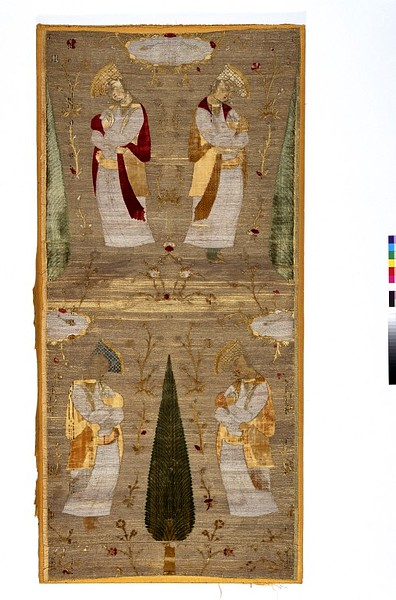
The second phase, developed during the lifetime and in the court of Shah Abbas I (r. 1589-1627), was dominated by and almost entirely determined by the style of his chief painter, Riza-i Abbasi, as his striking images were imitated on numerous velvets. Riza portrayed individual figures and reduced the setting to incidental space filling.
Victoria and Albert Museum. |
 |  |
Early 17th century Qaba, given to Queen Christiana of Sweden by Russian Czar Alexei I in 1644.
The Riza Abassi-style fabric and probably the garment are from earlier in the 17th century.
Now in the Royal Armory of Stockholm. From "The Arts of Persia", by Hossein Amirsadeghi. |
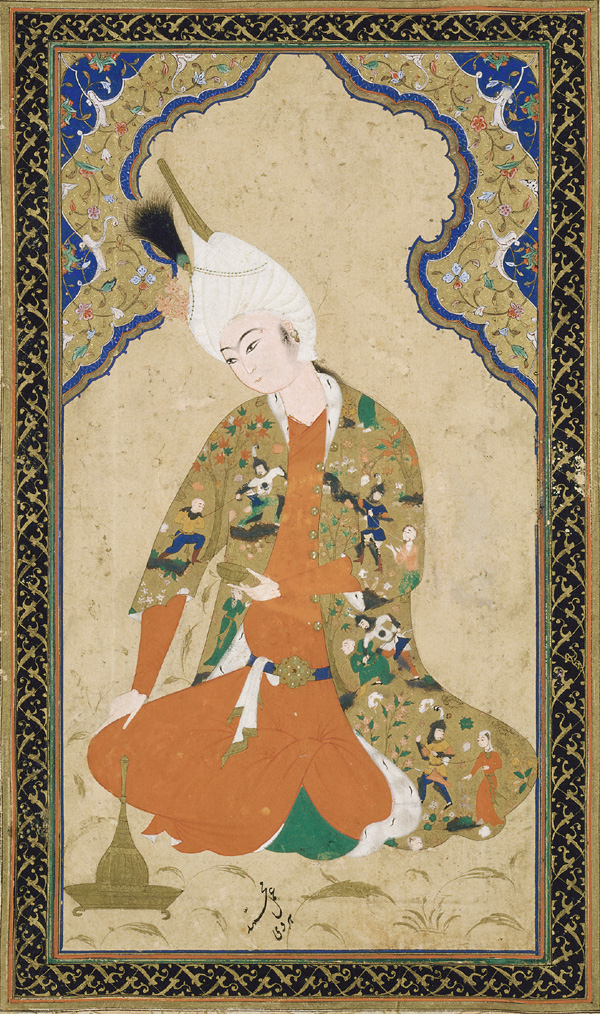 | Some scholars said there are no paintings of people wearing figurative robes.
This is just one of several i have found.
Young Prince
mid-16th century
Signed by Muhammad Haravi
The Smithsonian Institute. |
|
While these motifs are not commonly reproduced today, keep searching, because sometimes they turn up. I found the Horseman with Captive on a printed upholstery cotton several years ago. And an "expurgated" version of a feline and herbivore in a cut-velvet upholstery jacquard, where, on a blue ground, beige animals are separated, so no real attack is depicted. I also found chiffon with figures holding cups and pitchers (it will need to be carefully lined). Vignettes are harder to find, but i have found a single-color jacquard damask with vignettes of animals, as well as some jacquard upholstery fabric with vignettes that are not too far off from Safavid designs.
|
|